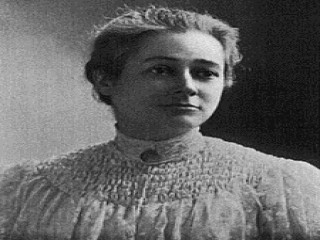
Florence Merriam Bailey biography
Date of birth : 1863-08-08
Date of death : 1948-09-22
Birthplace : Locust Grove, Lewis County, U.S.
Nationality : American
Category : Famous Figures
Last modified : 2011-05-10
Credited as : Ornithologist, and author, Birds of Village and Field
Florence Merriam Bailey wrote numerous works for a wide range of people interested in birding.
Aprominent ornithologist, Florence Merriam Bailey wrote numerous works for a wide range of people interested in birding. In addition to publishing technical guides for specialists in the field, Bailey was able to pique the interest of young people and novices through her informative and entertaining books.
The last of four children, Florence Augusta Merriam was born to Clinton Levi Merriam and Caroline Hart Merriam on August 8, 1863, in Locust Grove, a New York village in Lewis County. Merriam's mother was the daughter of County Judge Levi Hart. Her father, a merchant banker, retired about the time Merriam was born.
Merriam's love of nature was inspired by the natural setting of her family's home in the foothills of the Adirondack Mountains. It was also nurtured by her father and by her brother, Clinton, a physician and a naturalist, who eventually became the chief of the U.S. Biological Survey.
Because she planned to be a writer, Merriam attended the newly-opened Smith College in Northampton, Massachusetts, for four years as a special student. Although she left in 1886 without a degree, Smith awarded her one in 1921. While at Smith, Merriam led nature groups into the countryside, founded one of the nation's first Audubon societies, and wrote articles on birds for Audubon Magazine.
The Audubon articles became the core of her first book, Birds through an Opera Glass (1889), which was part of a series for young people. The first book's entertaining style, enhanced by close observation and enthusiasm for the subjects, became Merriam's hallmark.
In addition to her love of nature, Merriam was also interested in people. During the summer of 1891 she worked a month at a Chicago school for working girls, and that same winter she worked in a working girl's club in New York City. Her social service was curtailed when she contracted tuberculosis, an illness that prompted Merriam to travel west in 1893 in search of a better climate in which to recover.
Life in a small Utah town led to Merriam's My Summer in a Mormon Village (1894), a description of everyday Mormon life. From Utah, Merriam traveled to Palo Alto, California, where she attended Stanford University for six months. In the spring of 1894, she visited Twin Oaks, an area of California, to take notes on birds, and then moved on to observe in the mountains of Arizona.
Her trip west had a profound influence on her career. A Birding on a Bronco (1896), her first big western bird book, written for beginners in ornithology, became one of the first popular American bird guides. Merriam's Handbook of the Birds of the Western United States (1902) complemented Frank Chapman's Handbook of Birds of Eastern North America (1895). The handbook became a standard reference book—informative, succinct, technical, and filled with illustrations of the area's hundreds of species.
Birds of New Mexico (1928), originally intended for inclusion in a Biological Survey report, became in Merriam's hands a comprehensive book for general use. It won her the Brewster Medal of the American Ornithologist's Union in 1931—she was the first woman to be thus honored. Two years later she received an honorary LL.D. from the University of New Mexico.
Both the handbook and the New Mexico volumes contain substantial contributions by biologist Vernon Bailey, who later became the chief naturalist of the U.S. Biological Survey. Merriam met Vernon at her brother's home in Washington, D.C., and married him on December 16, 1899. Shortly after their marriage, Vernon began a series of biological field trips to New Mexico, often accompanied by Florence. Over the years, each contributed to the other's books. Her New Mexico book and his Mammals of New Mexico (1931) are considered classics on western natural history.
Although Florence looked delicate, her arduous travels testified to her stamina and unflagging spirit. From one end of the country to the other, the Baileys journeyed by railroad, wagon, pack train, or on foot. Although the couple remained childless, Florence aimed to transmit her love of birds to young people. The subtitle of her fourth book, Birds of Village and Field: A Bird Book for Beginners, suggests that she had youngsters in mind.
When the Baileys were not away on a field trip, their home in Washington, D.C., was a gathering place for amateur and professional naturalists, young and old. Florence tirelessly promoted the Audubon Society of Washington, D.C., which she helped to found in 1887. She also directed and taught the society's program for teachers of nature studies.
The last major work of Florence Merriam Bailey, Among the Birds in the Grand Canyon National Park (1939), was published by the National Park Service just four years before her husband's death and nearly ten years before her own death on September 22, 1948, of myocardial degeneration. She is buried on the grounds of her childhood home in Locust Grove, New York.
















